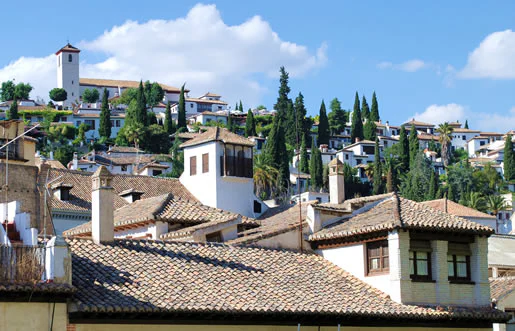Court of the Myrtles
The Court of the Myrtles (Patio de los Arrayanes) has received different names throughout time. Its current name is due to the myrtle bushes that surround the central pond and the bright green colour of which contrasts with the white marble of the patio. It was also called the Patio of the Pond or the Reservoir (Patio del Estanque o de la Alberca) because of the central pond, which is 34 metres long and 7,10 meters wide. The pond divides the patio and receives its water from two fountains (one at each end of the pond). There are chambers on both sides of the patio and several porticoes on the shorter sides of it. These porticoes rest on columns with cubic capitals, which have seven semicircular arches decorated with fretwork rhombuses and inscriptions praising God. The central arch is greater than the other six and has solid scallops decorated with stylised vegetal forms and capitals of mocarabes.
On the ends of the southern gallery are larders with kitchen shelves of mocarabes and the following legend: «May our Master Abu Abd' Allah, emir of the Muslims, receive God's help and protection as well as a glorious victory». Most inscriptions that appear in this patio are praises to God or to the emir. The chambers that existed in this portico were partly demolished in order to build the Charles V Palace (Palacio de Carlos V). On the top floor, on a corridor, there is a six-arched gallery with a higher lintel in the centre. This gallery is decorated with wooden terraced bases covered with stylised vegetal forms and latticework from the 19th century.
As it has already been said, several chambers have disappeared, but certain signs of their existence have been found. The disappearance of these chambers has contributed to the popular belief of the legend that says that Charles V destroyed the winter palace of the Alhambra in order to build his own. However, several experts, although in disagreement about the content of these chambers, do agree on the lack of signs to determine the existence of the winter palace.
The lateral sections were the women's residence. On the ground floor several doors connect (or used to connect) with other chambers. The patio's decoration in this gallery, except for the tile skirting board, was redone during the 19th century, copying that of the opposite portico.
On the top part of the northern gallery, behind which the Comares Tower (Torre de Comares) stood, there is a parapet with two little lateral towers, which were remade in 1890 because this gallery's and the following hall's ceiling burned. The gallery's ends have larders with arches, domes and kitchen shelves of mocarabes, on a skirting board covered with tiles from the 16th century. On the top of the skirting board there is an inscription from a poem by Ibn Zamrak in honour of Mohammed V after Algeciras was conquered in 1368.
Read more about...



